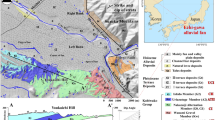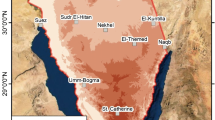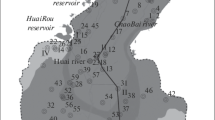Abstract
Because of unknown faults and fractures in the overlying rock, CO2 stored deep underground may move upward, and the intrusion may impact shallow groundwater quality. After leakage of CO2 has ceased, the affected aquifer may show remediation capacity under natural conditions and injections and extractions. In this study, the reactive transport modeling software TOUGHREACT was used to simulate the remediation capacity of a study aquifer. The simulation results show that the intrusion of leaked CO2 would decrease the pH of the target aquifer and trigger the dissolution of calcite minerals. After CO2 leakage has ceased, the pH would increase as would the concentration of Ca because of the dissolution of calcite along the flow path. Scenario simulation results of amelioration of groundwater quality by water injection and extraction show that single injection is the best option and a combination approach of injection and extraction could control the range of the affected area. The pH value should not be regarded as the single indicator for remediation capacity assessment. Parameter sensitive analysis results show that the rates of injection and extraction affect the repair results significantly.

















Similar content being viewed by others
References
Appelo CAJ, Postma D (2005) Geochemistry, groundwater and pollution. A. A. Balkema, Rotterdam
Apps JA, Zheng L, Zhang Y (2010) Evaluation of groundwater quality changes in response to CO2 leakage from deep geological storage. Transp Porous Media 82:215–246. doi:10.1007/s11242-009-9509-8
Bachu S (2000) Sequestration of CO2 in geological media: criteria and approach for site selection in response to climate change. Energy Conserv Manag 42:953–970. doi:10.1016/S0196-8904(99)00149-1
Du SH, Su XS, Xu W (2015) Assessment of CO2 geological storage capacity in oilfields of Songliao Basin, Northeastern China. Geosci J. doi:10.1007/s12303-015-0037-y
Esposito A, Benson SM (2011) Remediation of possible leakage from geologic CO2 storage reservoirs into groundwater aquifers. Energy Procedia 4:3216–3223. doi:10.1016/j.egypro.2011.02.238
Humez P, Audigane P, Lions J (2011) Modeling of CO2 leakage up through an abandoned well from deep saline aquifer to shallow fresh groundwater. Transport porous Meida 90:153–181. doi:10.1007/s11242-011-9801-2
Kharaka YK, Thordsen JJ, Kakouros E (2010) Changes in the chemistry of shallow groundwater related to the 2008 injection of CO2 at the ZERT field site, Bozeman, Montana. Environmental Earth Sciences 60:273–284. doi:10.1007/s12665-009-0401-1
Kuo CW, Benson SM (2015) Numerical and analytical study of effects of small scale heterogeneity on CO2/brine multiphase flow system in horizontal corefloods. Adv Water Resour 79:1–17. doi:10.1016/j.advwatres.2015.01.012
Lasaga AC, Soler JM, Ganor J (1994) Chemical weathering rate laws and global geochemical cycles. Geochim Cosmochim Acta 58:2361–2386. doi:10.1016/0016-7037(94)90016-7
Lemieux JM (2011) Review: the potential impact of underground geological storage of carbon dioxide in deep saline aquifer on shallow groundwater resources. Hydrogeol J 19:757–778. doi:10.1007/s10040-011-0715-4
Little MG, Jackson RB (2010) Potential impacts of leakage from deep CO2 geosequestration on overlying freshwater aquifers. Environmental Science & Technology 44:9225–9232. doi:10.1021/es102235w
Lu JM, Partin JW, Hovorka SD (2010) Potential risks to freshwater resources as a result of leakage from CO2 geological storage: a batch-reaction experiment. Environ Earth Sci 60:335–348. doi:10.1007/s12665-009-0382-0
Palandri JL and Kharaka YK (2004) A compilation of rate parameters of water-mineral interaction kinetics for application to geochemical modeling. U. S. Geological Survey report (2004-1068)
Salmasi F, AZamathulla HM (2013) Determination of optimum relaxation coefficient using finite difference method for groundwater flow. Arab J Geosci 6:3409–3415. doi:10.1007/s12517-012-0591-9
Siirila ER, Nacarre-sitchler AK, Maxwell RM, McCray JE (2012) A quantitative methodology to assess the risk to human health from CO2 leakage into groundwater. Adv Water Resour 96:146–164. doi:10.1016/j.advwatres.2010.11.005
Smyth RC, Hovorka SD, Lu J (2009) Assessing risk to fresh water resources from long term CO2 injection- laboratory and field studies. Energy Procedia 1:1957–1964. doi:10.1016/j.egypro.2009.01.255
Steefel CI, Lasaga AC (1994) A coupled model for transport of multiple chemical species and kinetic precipitation/dissolution reactions with application to reactive flow in single phase hydrothermal systems. Am J Sci 294:529–592. doi:10.2475/ajs.294.5.529
Su XS, Xu W, Du SH (2013) Basin-scale storage capacity assessment of deep saline aquifers in the Songliao Basin, Northeastern China. Greenhouse Gases: Sci Technol 3:266–280. doi:10.1002/ghg.1354
Trautz RC, Pugh JD, Varadharajan C, Zheng L, Bianchi M, Nico PS, Spycher NF, Newell DL, Esposito RA, Wu Y, Dafflon B, Hubbard SS, Birkholzer JT (2012) Effect of dissolved CO2 on a shallow groundwater system—a controlled release field experiment. Environ Sci Technol 47:298–305. doi:10.1021/es301280t
Vong CQ, Jacquemet N, Picot-Colbeaux G (2011) Reactive transport modeling for impact assessment of a CO2 intrusion on trace elements mobility within fresh groundwater and its natural attenuation for potential remediation. Energy Procedia 4:3171–3178. doi:10.1016/j.egypro.2011.02.232
Wu Y, Forsyth P (2006) Efficient scheme for reducing numerical dispersion in modeling multiphase chemical transport in porous and fractured media, Proceedings of TOUGH Symposium. Lawrence Berkeley National Laboratory, Berkeley, California
Xu T, Sonnenthal E, Spycher N (2004) TOUGHREACT user’s guider: a simulation program for nonisothermal multiphase reactive geochemical transport in variably saturated geologic media. Lawrence Berkeley National Lab report
Xu T, Nicolas S, Sonnenthal E, Zhang GX, Zheng L, Pruess K (2011) TOUGHREACT version 2.0: a simulator for subsurface reactive transport under non-isothermal multiphase flow conditions. Comput Geosci 37:763–774. doi:10.1016/j.cageo.2010.10.007
Yang CB, Hovorka SD, Trevino RH, Delgado-Alonso J (2015) Integrated framework for assessing impacts of CO2 leakage on groundwater quality and monitoring-network efficiency: case study at a CO2 enhanced oil recovery site. Environ Sci Technol 49:8887–8898. doi:10.1021/acs.est.5b01574
Zhao RR, Cheng JM, Zhang K, Liu N, Xu FQ (2015) Numerical investigation of basin-scale storage of CO2 in saline aquifers of Songliao Basin, China. Greenhouse Gases: Sci Technol 5:180–197. doi:10.1002/ghg.1473
Zheng L, Apps JA, Zhang Y (2009) On mobilization of lead and arsenic in groundwater in response to CO2 leakage from deep geological storage. Chem Geol 268:281–297. doi:10.1016/j.chemgeo.2009.09.007
Zheng L, Apps JA, Spycher N (2012) Geochemical modeling of changes in shallow groundwater chemistry observed during the MSU-ZERT CO2 injection experiment. Int J Greenhouse Gas Control 7:202–217. doi:10.1016/j.ijggc.2011.10.003
Zheng L, Spycher N, Varadharajan C, Tinnacher RM, Pugh JD, Bianchi M, Birkholzer J, Nico PS, Trautz RC (2015) On the mobilization of metals by CO2 leakage into shallow aquifers: exploring release mechanisms by modeling filed and laboratory experiments. Greenhouse Gases: Sci Technol 5:403–418. doi:10.1002/ghg.1493
Zhu QL, Li XC, Jiang ZB, Wei N (2015) Impacts of CO2 leakage into shallow formations on groundwater chemistry. Fuel Process Technol 135:162–167. doi:10.1016/j.fuproc.2014.11.042
Acknowledgments
This work was supported by the Electric Power Research Institute; the EPA, Office of Water, under an Interagency Agreement with the US Department of Energy (DOE) at LBNL, under contract number DE-AC02-05CH11231; and the Assistant Secretary for Fossil Energy, National Energy Technology Laboratory (NETL), National Risk Assessment Program (NRAP), of the US Department of Energy under contract number DEAC02-05CH11231. This work also was supported by the Jilin Province Science and Technology Development Plan (No. 20140520143JH) and the Multi-Subjects Research Program for Ph.D. Student in Jilin University (2011J012). Thanks to the anonymous reviewers’ and editor’s suggestions and comments which greatly helped the authors to improve the quality of the paper.
Author information
Authors and Affiliations
Corresponding author
Rights and permissions
About this article
Cite this article
Du, S., Zheng, L. & Zhang, W. Assessment of shallow aquifer remediation capacity under different groundwater management conditions in CGS field. Arab J Geosci 9, 448 (2016). https://doi.org/10.1007/s12517-016-2479-6
Received:
Accepted:
Published:
DOI: https://doi.org/10.1007/s12517-016-2479-6




